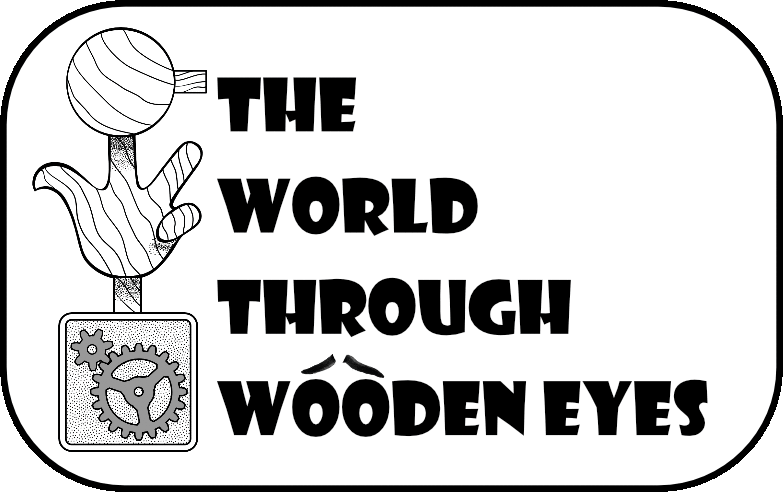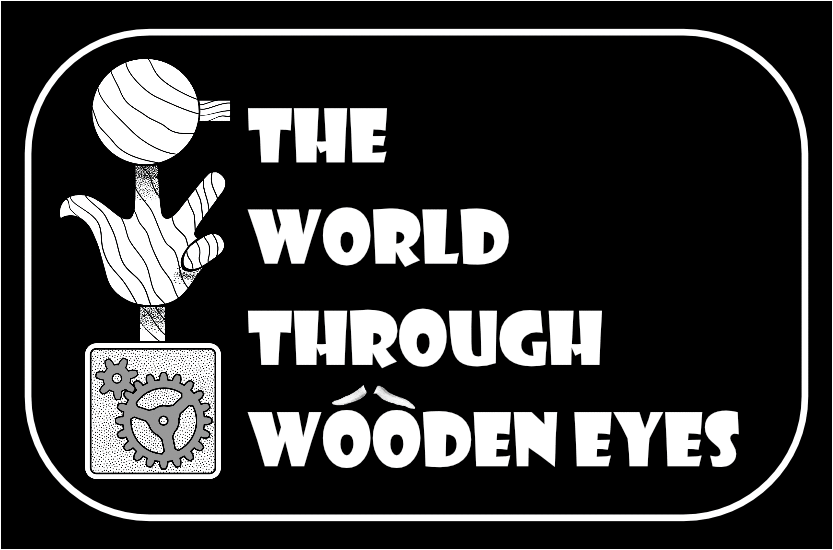NAVIGATION
SOCIAL
CONTACT
e-mail: info@theworldthroughwoodeneyes.co.uk

Sergei Chepik
In
the
1970’s,
by
accident
I
discovered
the
extraordinary
Russian
artist
Sergei
Chepik.
During
a
walkabout
in
St
Petersburg
I
came
upon
the
marionette
theatre,
of
Yevgeni Demeni, one of the oldest in Russia. Curiosity led me inside.
In
the
foyer
of
the
theatre,
there
I
saw
an
artist
working
on
a
vast
mural
on
the
wall
of
the
staircase.
I
later
discovered
that
this
complex
and
highly
detailed
mural
full
of
images
of
puppets
and
popular
theatre
motifs
was,
in
fact,
a
woven
tapestry.
Unfortunately,
lack
of
time,
and
the
Russian
language,
made
it
difficult
to
linger
longer
and
speak to the artist. Although I did mange to take some photographs.
Many
years
later
I
found
a
well-illustrated
catalogue
for
an
exhibition
by
a
Russian
artist
Sergei
Chepik,
at
the
Roy
Miles
Gallery
in
London.
I
was
curious
about
many
of
the
images
that
it
contained.
Not
only
did
they
depict
complex
work
similar
to
that
of
the
artist
working
on
the
mural,
they
also
contained
many
images
of
Petrushka
and
puppets.
I
wrote
to
Roy
Miles
to
help
me
contact
Chepik,
but
at
first
he
was
very
reluctant
to
do
so.
I
later
paid
him
a
visit
at
his
gallery
and
showed
him
the
photographs
that
I
had;
they
surprised
him.
He
finally
offered
to
forward
a
letter
to
Chepik.
He
duly
kept
his
promise,
and
shortly
afterwards
I
received
a
delightful
letter
from
him
asking
me
why
it
had
taken
so
long
to
make
contact.
Since
that
time
we
have
been
good
friends
and
have
been
able
to
amass
a
large
collection
of
material
about
his
work,
including
a
fine
detailed
engraving
that
he
presented
me
with
and
bearing
the
title
‘Hoffmann
Tales’
depicting
numerous
resting
marionettes,
including
‘Petrushka’
a
character that appears in many of his paintings.
Chepik was born in Kiev in 1953, the son of the painter Mikhail Chepik and the sculptor Ludmila Sabaneeva.
Chepik
was
a
child
prodigy
and
entered
a
number
of
leading
academies
of
art
in
Kiev,
and
Leningrad.
In
1978
he
graduated
from
the
famous
Repin
Art
Institute,
and
entered the Union of Young Artists in Leningrad.
After this he continued to study in the studio of Professor Mylinikov, and subsequently became a member of the USSR Union of Artists.
In
1986
he
met
Marie-Aude
Albert,
a
French
Teacher
in
the
University
of
Leningrad,
and
whom
Chepik
later
married.
She
has
been
responsible
for
writing
a
vast
wealth
of
texts
for
catalogues
and
interviews
with
Chepik.
She
also
authored
three
major
illustrated
monographs
of
his
extraordinary
creative
out
put.
This
contains,
paintings,
drawings, engravings, ceramics and sculptures.
In
1988
Chepik
immigrated
to
Paris
after
a
number
of
major
exhibitions
in
Russia.
In
the
same
year
he
exhibited
in
London
for
the
first
time,
in
the
Roy
Miles
Gallery,
and
the following year in a second group exhibition of ‘Russian Paintings’.
The
following
year
Chepik
had
his
first
Solo
Retrospective
Exhibition
at
the
Roy
Miles
Gallery;
it
was
a
sell-out,
and
received
great
public
acclaim,
and
was
described
in
The
Daily
Telegraph
as
‘An
unknown
Russian
genius
has
come
to
light’.
Virtually
every
year
since
he
had
solo
exhibitions
in
London,
apart
from
many
exhibitions
in
Europe
where he won numerous prestigious awards and distinctions for his work.
Amongst his many outstanding personality portrait commissions were one of Margaret Thatcher, and the last portrait of Rudolf Nureyev.
In
2002,
Chepik
exhibited
his
masterpiece
‘Golgotha’
In
St
Paul’s
Cathedral.
In
2005
the
inauguration
of
four
large
canvases
took
place,
with
the
title
‘I
am
the
way,
the
Truth and the Life’ by the Dean of St Paul’s Cathedral.
I
very
well
remember
a
visit
to
his
immaculate
Paris
studio,
high
above
the
rooftops
overlooking
the
city.
The
studio
wall
hung
with
many
familiar
pieces
of
his
work.
On
his
easel
stood
a
large
newly
finished
painting
with
its
back
facing
us.
He
started
to
play
part
of
a
recording
of
Carl
Orff’s
‘Carmina
Burana’,
and
slowly
turned
the
painting
around, it was his masterpiece ‘Golgotha’. It was such a memorable, powerful, dramatic and moving experience.
In
recent
years
he
concentrated
on
a
number
of
extraordinarily
dramatic
religious
masterpieces.
Even
so,
he
continued
to
return
to
his
cultural
roots
as
a
source
of
inspiration. His Russian landscapes and works based on folk tales are some of the finest examples of Russian art that exist.
Chepik’s
vast
output
also
contains
work
based
on
his
love
and
respect
for
popular
forms
of
entertainment
and
their
performers,
including
the
puppet
theatre,
boxing,
bullfighting,
the
circus,
the
Venetian
Carnival,
and
the
Parisian
cabaret.
He
spent
a
year
drawing
all
aspects
of
the
lives
and
work
of
the
artistes
of
the
world
famous
Moulin Rouge. The opening of his exhibition of this work in London was accompanied by a troupe of ‘Can Can Dancers’ in full costume.
In
so
many
of
his
early
works,
Petrushka
and
other
puppets
are
strongly
represented.
He
spent
a
great
deal
of
time
in
his
early
career
with
the
puppeteers
of
Yevgeni
Demeni’s
marionette
theatre
which
obviously
inspired
his
remarkable
mural
in
the
foyer
of
the
theatre,
and
his
continuing
love
of
puppets
and
puppeteers
which
he
depicts with carefully observed and knowledgeable detail.
The
are
three
lavish
mono
graphs
of
Chepik’s
wide
ranging
works
and
ideas,
illustrated
by
fine
detailed
coloured
and
black
and
white
photographs,
each
book
written
by
Marie-Aude Albert
Sergei Chepik, works 1970 to 1994’.
Sergei Chepik. From the Red Square to the Moulin Rouge ‘ works 1994-2001.
‘Epiphania, the religious paintings of Sergei Chepik’.
Sergei
Chepik
(click
for
his
website),
with
our
great
friend
Edward
Bersudsky
the
creator
of
Sharmanka’s
unique
kinemats
represents
the
genius
of
Russian
art
and
culture abroad.
Sergei Chepik died suddenly on the 18th November 2011 in his studio; he was 58 years of age.
John M. Blundall.

CONTACT
e-mail: info@theworldthroughwoodeneyes.co.uk
SOCIAL

In
the
1970’s,
by
accident
I
discovered
the
extraordinary
Russian
artist
Sergei
Chepik.
During
a
walkabout
in
St
Petersburg
I
came
upon
the
marionette
theatre,
of
Yevgeni
Demeni,
one
of
the
oldest
in
Russia.
Curiosity
led
me
inside.
In
the
foyer
of
the
theatre,
there
I
saw
an
artist
working
on
a
vast
mural
on
the
wall
of
the
staircase.
I
later
discovered
that
this
complex
and
highly
detailed
mural
full
of
images
of
puppets
and
popular
theatre
motifs
was,
in
fact,
a
woven
tapestry.
Unfortunately,
lack
of
time,
and
the
Russian
language,
made
it
difficult
to
linger
longer
and
speak
to
the
artist. Although I did mange to take some photographs.
Many
years
later
I
found
a
well-illustrated
catalogue
for
an
exhibition
by
a
Russian
artist
Sergei
Chepik,
at
the
Roy
Miles
Gallery
in
London.
I
was
curious
about
many
of
the
images
that
it
contained.
Not
only
did
they
depict
complex
work
similar
to
that
of
the
artist
working
on
the
mural,
they
also contained many images of Petrushka and puppets.
I
wrote
to
Roy
Miles
to
help
me
contact
Chepik,
but
at
first
he
was
very
reluctant
to
do
so.
I
later
paid
him
a
visit
at
his
gallery
and
showed
him
the
photographs
that
I
had;
they
surprised
him.
He
finally
offered
to
forward
a
letter
to
Chepik.
He
duly
kept
his
promise,
and
shortly
afterwards
I
received
a
delightful
letter
from
him
asking
me
why
it
had
taken
so
long
to
make
contact.
Since
that
time
we
have
been
good
friends
and
have
been
able
to
amass
a
large
collection
of
material
about
his
work,
including
a
fine
detailed
engraving
that
he
presented
me
with
and
bearing
the
title
‘Hoffmann
Tales’
depicting
numerous
resting
marionettes,
including
‘Petrushka’
a
character
that
appears
in many of his paintings.
Chepik
was
born
in
Kiev
in
1953,
the
son
of
the
painter
Mikhail Chepik and the sculptor Ludmila Sabaneeva.
Chepik
was
a
child
prodigy
and
entered
a
number
of
leading
academies
of
art
in
Kiev,
and
Leningrad.
In
1978
he
graduated
from
the
famous
Repin
Art
Institute,
and
entered the Union of Young Artists in Leningrad.
After
this
he
continued
to
study
in
the
studio
of
Professor
Mylinikov,
and
subsequently
became
a
member
of
the
USSR Union of Artists.
In
1986
he
met
Marie-Aude
Albert,
a
French
Teacher
in
the
University
of
Leningrad,
and
whom
Chepik
later
married.
She
has
been
responsible
for
writing
a
vast
wealth
of
texts
for
catalogues
and
interviews
with
Chepik.
She
also
authored
three
major
illustrated
monographs
of
his
extraordinary
creative
out
put.
This
contains,
paintings,
drawings, engravings, ceramics and sculptures.
In
1988
Chepik
immigrated
to
Paris
after
a
number
of
major
exhibitions
in
Russia.
In
the
same
year
he
exhibited
in
London
for
the
first
time,
in
the
Roy
Miles
Gallery,
and
the
following
year
in
a
second
group
exhibition
of
‘Russian
Paintings’.
The
following
year
Chepik
had
his
first
Solo
Retrospective
Exhibition
at
the
Roy
Miles
Gallery;
it
was
a
sell-out,
and
received
great
public
acclaim,
and
was
described
in
The
Daily
Telegraph
as
‘An
unknown
Russian
genius
has
come
to
light’.
Virtually
every
year
since
he
had
solo
exhibitions
in
London,
apart
from
many
exhibitions
in
Europe
where
he
won
numerous
prestigious
awards
and
distinctions
for
his
work.
Amongst
his
many
outstanding
personality
portrait
commissions
were
one
of
Margaret
Thatcher,
and
the
last
portrait of Rudolf Nureyev.
In
2002,
Chepik
exhibited
his
masterpiece
‘Golgotha’
In
St
Paul’s
Cathedral.
In
2005
the
inauguration
of
four
large
canvases
took
place,
with
the
title
‘I
am
the
way,
the
Truth
and the Life’ by the Dean of St Paul’s Cathedral.
I
very
well
remember
a
visit
to
his
immaculate
Paris
studio,
high
above
the
rooftops
overlooking
the
city.
The
studio
wall
hung
with
many
familiar
pieces
of
his
work.
On
his
easel
stood
a
large
newly
finished
painting
with
its
back
facing
us.
He
started
to
play
part
of
a
recording
of
Carl
Orff’s
‘Carmina
Burana’,
and
slowly
turned
the
painting
around,
it
was
his
masterpiece
‘Golgotha’.
It
was
such
a
memorable, powerful, dramatic and moving experience.
In
recent
years
he
concentrated
on
a
number
of
extraordinarily
dramatic
religious
masterpieces.
Even
so,
he
continued
to
return
to
his
cultural
roots
as
a
source
of
inspiration.
His
Russian
landscapes
and
works
based
on
folk
tales
are
some
of
the
finest
examples
of
Russian
art
that exist.
Chepik’s
vast
output
also
contains
work
based
on
his
love
and
respect
for
popular
forms
of
entertainment
and
their
performers,
including
the
puppet
theatre,
boxing,
bullfighting,
the
circus,
the
Venetian
Carnival,
and
the
Parisian
cabaret.
He
spent
a
year
drawing
all
aspects
of
the
lives
and
work
of
the
artistes
of
the
world
famous
Moulin
Rouge.
The
opening
of
his
exhibition
of
this
work
in
London
was
accompanied
by
a
troupe
of
‘Can
Can
Dancers’
in
full
costume.
In
so
many
of
his
early
works,
Petrushka
and
other
puppets
are
strongly
represented.
He
spent
a
great
deal
of
time
in
his
early
career
with
the
puppeteers
of
Yevgeni
Demeni’s
marionette
theatre
which
obviously
inspired
his
remarkable
mural
in
the
foyer
of
the
theatre,
and
his
continuing
love
of
puppets
and
puppeteers
which
he
depicts
with
carefully
observed and knowledgeable detail.
The
are
three
lavish
mono
graphs
of
Chepik’s
wide
ranging
works
and
ideas,
illustrated
by
fine
detailed
coloured
and
black
and
white
photographs,
each
book
written
by
Marie-
Aude Albert
Sergei Chepik, works 1970 to 1994’.
Sergei
Chepik.
From
the
Red
Square
to
the
Moulin
Rouge
‘
works 1994-2001.
‘Epiphania, the religious paintings of Sergei Chepik’.
Sergei
Chepik
(click
for
his
website),
with
our
great
friend
Edward
Bersudsky
the
creator
of
Sharmanka’s
unique
kinemats
represents
the
genius
of
Russian
art
and
culture
abroad.
Sergei
Chepik
died
suddenly
on
the
18th
November
2011
in
his studio; he was 58 years of age.
John M. Blundall.
Sergei Chepik
































